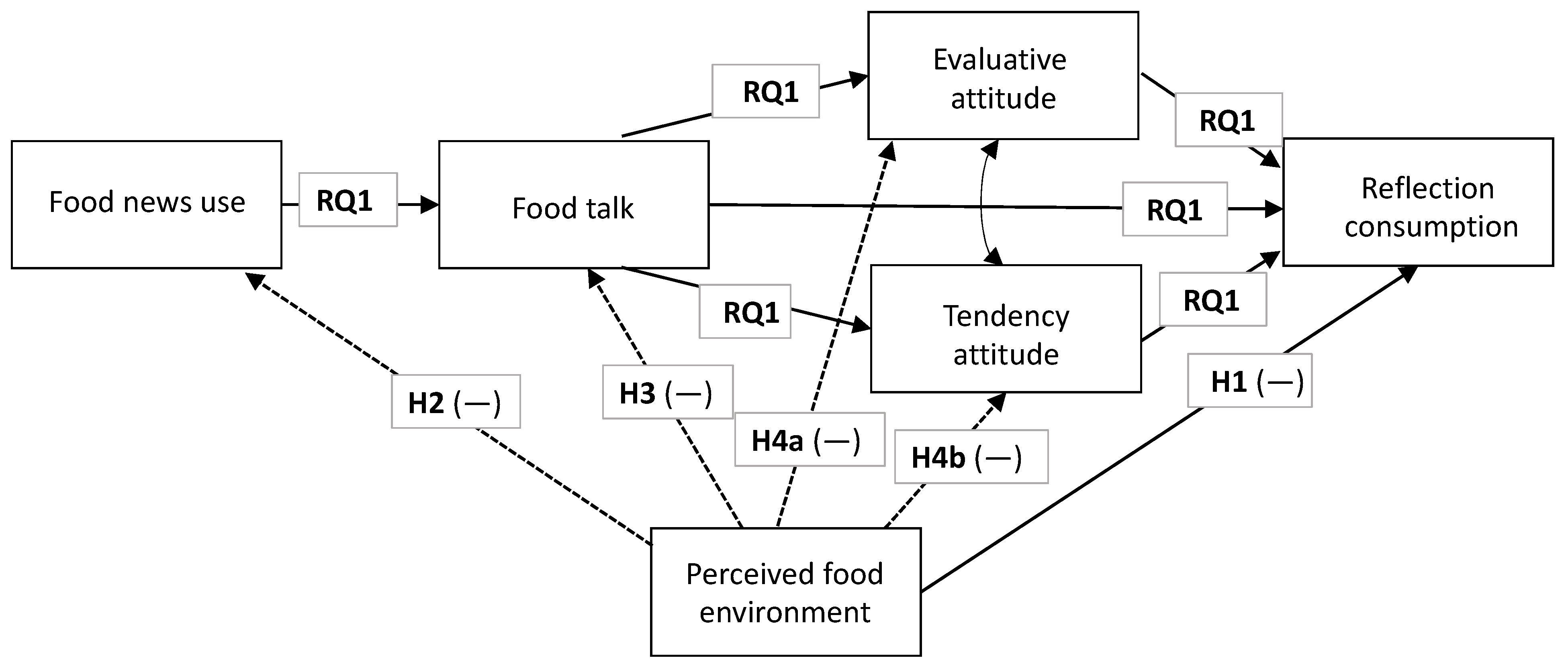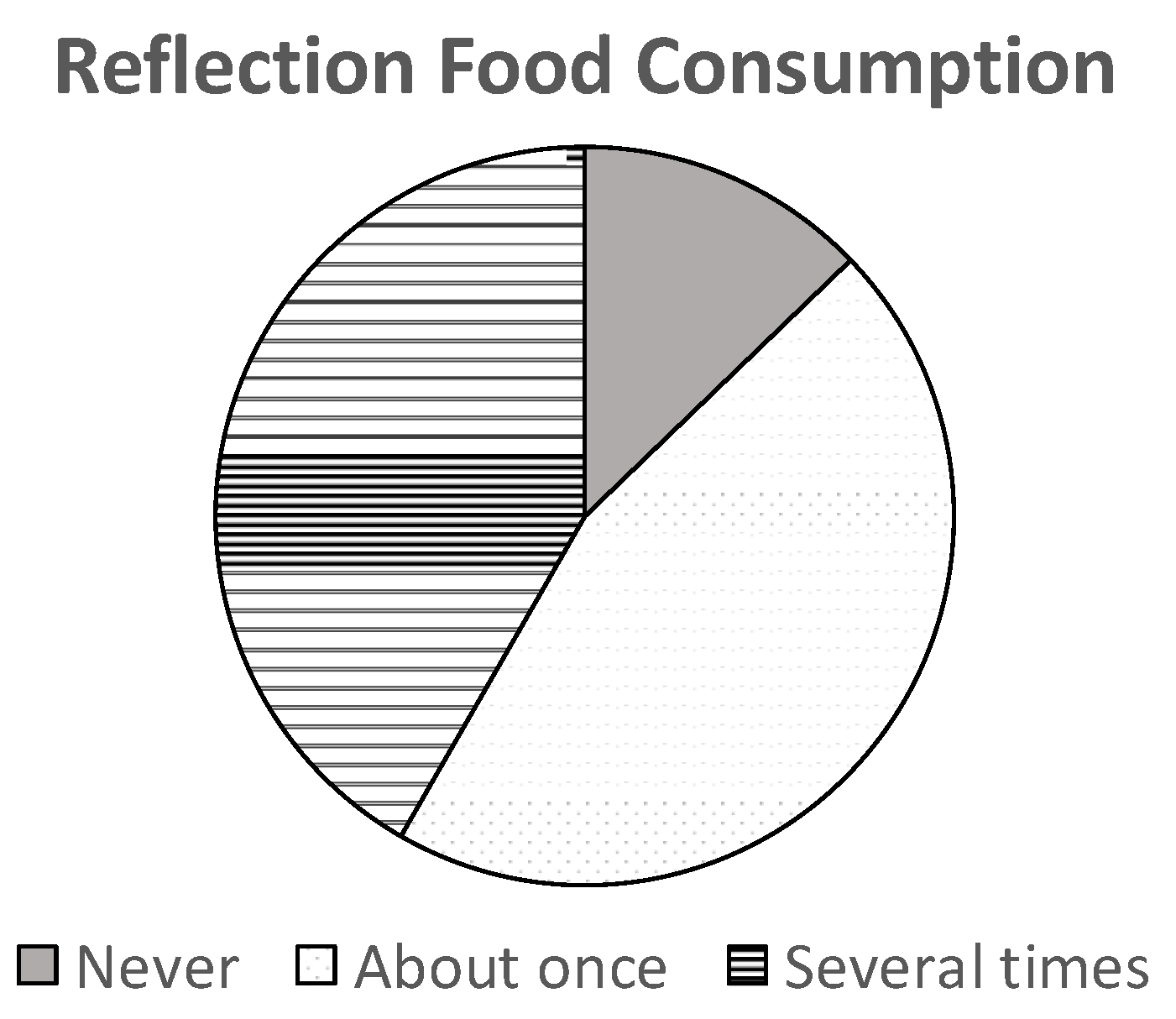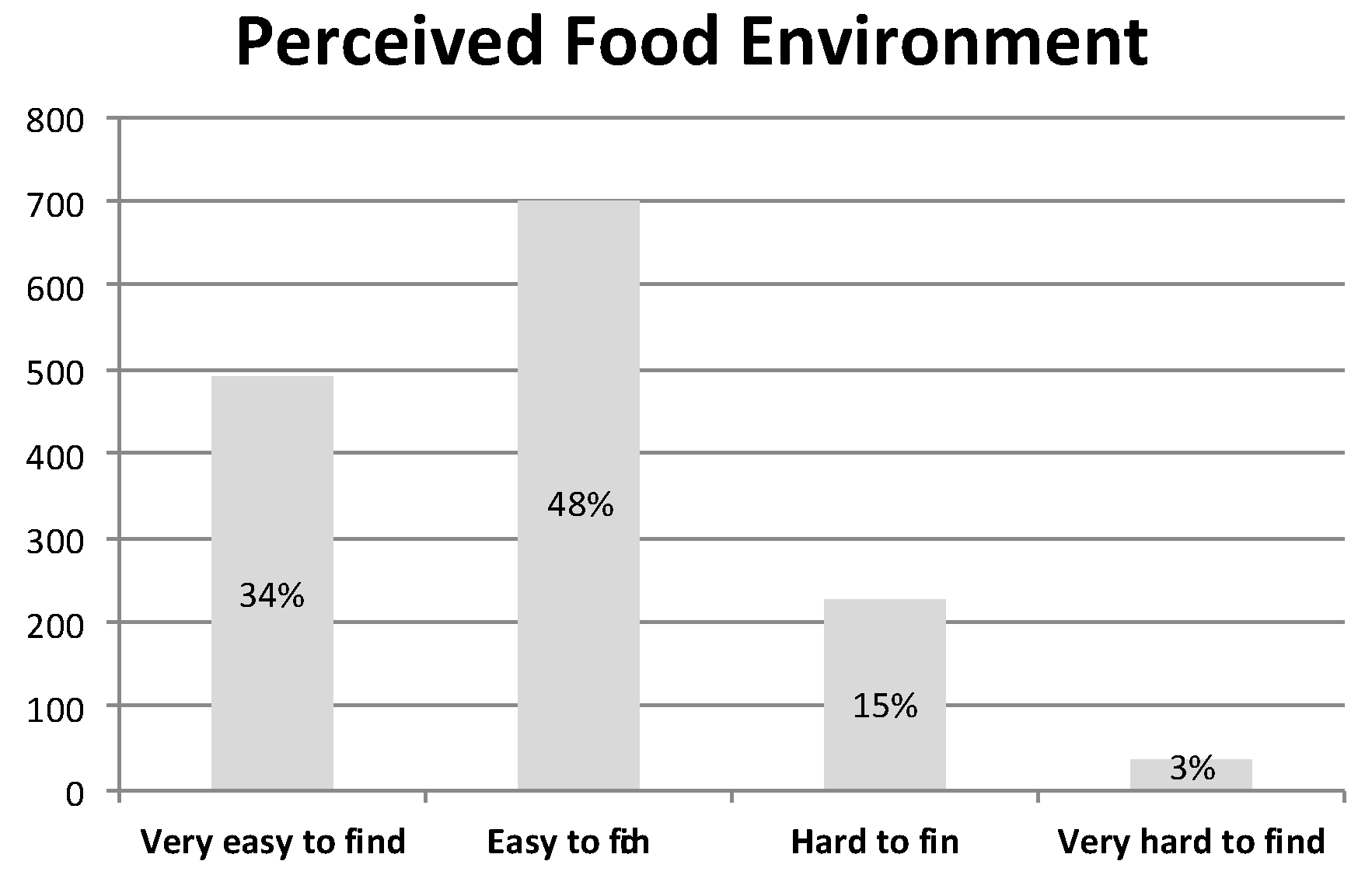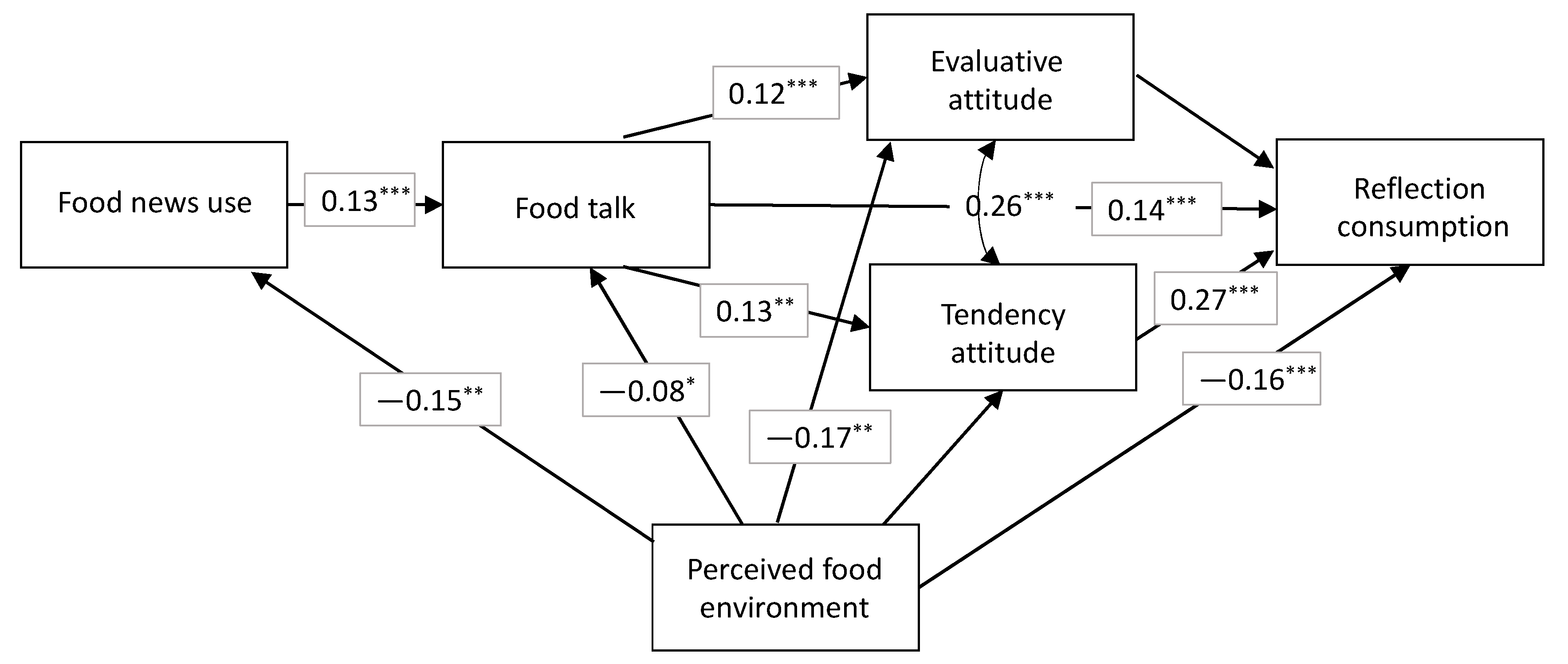Our Daily Communicative Contexts: More Evidence for the Food Environment Puzzle
Abstract
:1. Introduction
2. Related Literature and the Communication Mediation Model
2.1. Communicative Contexts
2.2. The Perceived Food Environment
2.3. Reflective Food Consumption
2.4. Beyond Direct Effects of the Perceived Food Environment
3. Methods
3.1. Data
Measures
3.2. Analysis
4. Results
4.1. Direct Relationship of a Difficult Food Environment with Reflective Food Consumption
4.2. Indirect Relationships of a Difficult Food Environment with Reflective Food Consumption
5. Discussion and Conclusions
5.1. Perceptions of a Difficult Food Environment
5.2. Limitations
5.3. Conclusions
Supplementary Materials
Author Contributions
Funding
Institutional Review Board Statement
Informed Consent Statement
Data Availability Statement
Acknowledgments
Conflicts of Interest
| 1 | RR1 (Response Rate) codes were modified to reflect the fact that this survey was a panel survey, not an RDD survey. All sample members were eligible. |
| 2 | When using a proxy, attention must be paid to both under- and overestimation of the true value of healthy food consumption. In terms of underestimation, it is entirely possible to consume healthy foods without purchasing organic, GMO-free, or local foodstuffs, and even without looking at labels. Therefore, some healthy food consumption is not accounted for in our dependent variable, which makes its use in our model, if anything, a conservative measure of healthy food consumption (i.e., our measure is a subset of the true healthy foods consumption). To be clear, we make no claims that organic, non-GMO, or even local foods are healthier, but that the (conscious) consumption of these types of food is associated with a healthy lifestyle (Kesse-Guyot et al. 2013) and is healthy. In terms of overestimation, we could not find studies, to our knowledge, linking unhealthy food habits and the consumption of organic, local, or non-GMO foods, or using food labels as consumption-decision tools—not even when such associations were sought (Baudry et al. 2017). While it is genuinely possible to eat organic, non-GMO, local, or purchase based on label-reading decisions and unhealthy foods, this is not only atypical but also fairly marginal. In conclusion, we consider the variable reflective food consumption to be a conservative measure of true healthy food consumption having little risk of being confounded with unhealthy food consumption. |
| 3 | All betas are reported as STDX standardized betas, which use the variances of the continuous latent variables and the background and/or outcome variables (see www.statmodel.com). (Accessed on 1 February 2021). |
References
- Abril, Eulàlia P. 2016. Explaining voluntary blood donation from a communication perspective. Cuadernos 38: 17–33. [Google Scholar] [CrossRef] [Green Version]
- Abril, Eulàlia P., and Hernando Rojas. 2018. Silencing Political Opinions: An Assessment of the Influence of Geopolitical Contexts in Colombia. Communication Research 45: 55–82. [Google Scholar] [CrossRef] [Green Version]
- Abt SRBI. 2016. Pew Research Center’s American Trends Panel–Wave 17. Methodology Report. New York: Abt SRBI. [Google Scholar]
- Ajzen, Icek, and Martin Fishbein. 1977. Attitude-behavior relations: A Theoretical analysis and review of empirical research. Psychological Bulletin 84: 888–918. Available online: http://www.thecre.com/tpsac/wp-content/uploads/2011/02/Appendix2_AttitudevsAction_ByAjzenFishbein1977.pdf (accessed on 1 February 2021). [CrossRef]
- Alber, Julia M., Sarah H. Green, and Karen Glanz. 2018. Perceived and observed food environments, eating behaviors, and BMI. American Journal of Preventive Medicine 54: 423–29. [Google Scholar] [CrossRef]
- Albert, Stephanie Lynn. 2017. #Consumingitall: Understanding the Complex Relationship between Media Consumption and Eating Behaviors. Los Angeles: University of California Los Angeles, Available online: https://escholarship.org/uc/item/1f75j34r (accessed on 1 February 2021).
- Arena, Ross, Amy McNeil, Michael Sagner, and Carl J. Lavie. 2017. Healthy Living: The Universal and Timeless Medicine for Healthspan. Progress in Cardiovascular Diseases 59: 41–21. [Google Scholar] [CrossRef] [PubMed] [Green Version]
- Baudry, Julia, Sandrine Péneau, Benjamin Allès, Mathilde Touvier, Serge Hercberg, Pilar Galan, Marie-Josèphe Amiot, Denis Lairon, Caroline Méjean, and Emmanuelle Kesse-Guyot. 2017. Food choice motives when purchasing in organic and conventional consumer clusters: Focus on sustainable concerns (the nutrinet-santé cohort study). Nutrients 9: 88. [Google Scholar] [CrossRef] [PubMed]
- Black, Christina, Graham Moon, and Janis Baird. 2014. Dietary inequalities: What is the evidence for the effect of the neighbourhood food environment? In Health and Place. Amsterdam: Elsevier Ltd., vol. 27, pp. 229–42. [Google Scholar] [CrossRef] [Green Version]
- Caldwell, Erin M., M. Miller Kobayashi, Wendy Dubow, and Sonya Wytinck. 2009. Perceived access to fruits and vegetables associated with increased consumption. Public Health Nutrition 12: 1743–50. [Google Scholar] [CrossRef] [Green Version]
- Caspi, Caitlin E., Glorian Sorensen, S. V. Subramanian, and Ichiro Kawachi. 2012. The local food environment and diet: A systematic review. Health and Place 18: 1172–87. [Google Scholar] [CrossRef] [Green Version]
- Chen, Danhong, Edward C. Jaenicke, and Richard J. Volpe. 2016. Food environments and obesity: Household diet expenditure versus food deserts. American Journal of Public Health 106: 881–88. [Google Scholar] [CrossRef]
- Cho, Jaeho, Dhavan V. Shah, Jack M. McLeod, Douglas M. McLeod, RosanneM. Scholl, and Melissa R. Gotlieb. 2009. Campaigns, reflection, and deliberation: Advancing an O-S-R-O-R model of communication effects. Communication Theory 19: 66–88. [Google Scholar] [CrossRef]
- Cooksey-Stowers, Kristen, Marlene B. Schwartz, and Kelly D. Brownell. 2017. Food swamps predict obesity rates better than food deserts in the United States. International Journal of Environmental Research and Public Health 14: 1366. [Google Scholar] [CrossRef] [Green Version]
- Courtemanche, Charles, and Art Carden. 2011. Supersizing supercenters? The impact of Walmart Supercenters on body mass index and obesity. Journal of Urban Economics 69: 165–81. [Google Scholar] [CrossRef]
- Cummins, Steven. 2007. Commentary: Investigating neighbourhood effects on health—Avoiding the “Local Trap”. International Journal of Epidemiology 36: 355–57. [Google Scholar] [CrossRef] [PubMed] [Green Version]
- Dubowitz, Tamara, Madhumita Ghosh-Dastidar, Christine Eibner, Mary E. Slaughter, Meenakshi Fernandes, Eric A. Whitsel, Chloe E. Bird, Adria Jewell, Karen L. Margolis, Wenjun Li, and et al. 2012. The women’s health initiative: The food environment, neighborhood socioeconomic status, BMI, and blood pressure. Obesity 20: 862–87. [Google Scholar] [CrossRef]
- Dubowitz, Tamara, Madhumita Ghosh-Dastidar, Deborah A. Cohen, Robin Beckman, Elizabeth D. Steiner, Gerald P. Hunter, Karen R. Flórez, Christina Huang, Christine A. Vaughan, Jennifer C. Sloan, and et al. 2015. Diet and perceptions change with supermarket introduction in a dood desert, but not because of supermarket use. Health Affairs 34: 1858–68. [Google Scholar] [CrossRef] [PubMed] [Green Version]
- Eagly, Alice Hendrickson, and Shelly Chaiken. 1993. The Psychology of Attitudes. Fort Worth: Harcourt Brace Jovanovich College Publishers. [Google Scholar]
- Fishbein, Martin, and Icek Ajzen. 1975. Belief, Attitude, Intention and Behavior: An Introduction to Theory and Research. Boston: Addison-Wesley. [Google Scholar]
- Flint, Ellen, Steven Cummins, and Stephen Matthews. 2013. Do perceptions of the neighbourhood food environment predict fruit and vegetable intake in low-income neighbourhoods? Health and Place 24: 11–15. [Google Scholar] [CrossRef] [Green Version]
- Friedland, Lewis A., and Jack M. McLeod. 1999. Community integration and mass media: A reconsideration. In Mass Media, Social Control, and Social Change: A Macrosocial Perspective. Edited by David Demers and Kasisomayajula Viswanath. Ames: Iowa State University Press, pp. 197–226. [Google Scholar]
- Gase, Lauren N., Beth Glenn, and Tony Kuo. 2016. Self-efficacy as a mediator of the relationship between the perceived food environment and healthy eating in a low income population in Los Angeles County. Journal of Immigrant and Minority Health 18: 345–52. [Google Scholar] [CrossRef]
- Geller, Alan C., Karen Emmons, Daniel R. Brooks, Zi Zhang, Catherine Powers, Howard K. Koh, Arthur J. Sober, Donald R. Miller, Frederick Li, Frank Haluska, and et al. 2003. Skin cancer prevention and detection practices among siblings of patients with melanoma. Journal of the American Academy of Dermatology 49: 631–38. Available online: https://ac-els-cdn-com.proxy.cc.uic.edu/S0190962203021261/1-s2.0-S0190962203021261-main.pdf?_tid=98c8eee1-a32b-44a0-9ecd-929b6f406857andacdnat=1520616800_3121296f099d3f9f4fda8806c6b3f503 (accessed on 1 February 2021). [CrossRef]
- Gil de Zúñiga, Homero, Brian Weeks, and Alberto Ardèvol-Abreu. 2017. Effects of the news-finds-me perception in communication: Social media use implications for news seeking and learning about politics. Journal of Computer-Mediated Communication 22: 105–23. [Google Scholar] [CrossRef] [Green Version]
- Glanz, Karen, James F. Sallis, Brian E. Saelens, and Lawrence D. Frank. 2005. Healthy nutrition environments: Concepts and measures. American Journal of Health Promotion. 19, pp. 330–33. Available online: https://pdfs.semanticscholar.org/e34b/bd76486cc91773d074ab0c0b4763eb520f53.pdf (accessed on 1 February 2021).
- Inglis, Victoria, Kylie Ball, and David Crawford. 2008. Evidence-based public health policy and practice Socioeconomic variations in women’s diets: What is the role of perceptions of the local food environment? Journal of Epidemiology and Community Health 62: 191–97. Available online: http://www.jstor.org/stable/20789214 (accessed on 1 February 2021). [CrossRef] [Green Version]
- Jardim, Thiago Veiga, Dariush Mozaffarian, Shafika Abrahams-Gessel, Stephen Sy, Yujin Lee, Junxiu Liu, Yue Huang, Colin Rehm, Parke Wilde, Renata Micha, and et al. 2019. Cardiometabolic disease costs associated with suboptimal diet in the United States: A cost analysis based on a microsimulation model. PLoS Medicine 16: e1002981. [Google Scholar] [CrossRef] [Green Version]
- Jung, Nakwon, Yonghwan Kim, and Homero. Gil de Zúñiga. 2011. The mediating role of knowledge and efficacy in the effects of communication on political participation. Mass Communication and Society 14: 407–30. [Google Scholar] [CrossRef]
- Kaplan, David. 2009. Structural Equation Modeling: Foundations and Extensions. Los Angeles: AGE Publications, vol. 10. [Google Scholar]
- Kaase, Max, and Andrew Kohut. 1996. Estranged Friends?: The Transatlantic Consequences of Societal Change. New York: Council on Foreign Relations Press. [Google Scholar]
- Kemmer, Debbie, Annie S. Anderson, and David W. Marshall. 1998. Living together and eating together: Changes in food choice and eating habits during the transition from single to married/cohabiting. The Sociological Review 46: 48–72. [Google Scholar] [CrossRef]
- Kesse-Guyot, Emmanuelle, Sandrine Péneau, Christine Méjean, Fabien Szabo de Edelenyi, Pilar Galan, Serge Hercberg, Denis Lairon, and Thierry Alquier. 2013. Profiles of organic food consumers in a large sample of French adults: Results from the Nutrinet-Santé cohort study. PLoS ONE 8: e76998. [Google Scholar] [CrossRef] [PubMed]
- Kilanowski, Jill F. 2010. Migrant farmworker mothers talk about the meaning of food. The American Journal of Maternal/Child Nursing 35: 330–35. [Google Scholar] [CrossRef] [PubMed] [Green Version]
- Kornfield, Rachel Glen Szczypka, Lisa M. Powell, and Sherry L. Emery. 2015. Televised obesity-prevention advertising across US media markets: Exposure and content, 2010–2011. Public Health Nutrition 18: 983–93. [Google Scholar] [CrossRef] [PubMed] [Green Version]
- Kwon, Min-Woo, Woohyun Yoo, and Michael Aguilar. 2013. Taking the die out of diet: Media and interpersonal communication’s impact on healthy eating habits. Journal of Communication in Healthcare 6: 3–12. [Google Scholar] [CrossRef]
- Larson, Nicole I., Mary T. Story, and Melissa C. Nelson. 2009. Neighborhood Environments. Disparities in Access to Healthy Foods in the U.S. American Journal of Preventive Medicine 36: 74–81. [Google Scholar] [CrossRef] [PubMed]
- Lucan, Sean C., and Nandita Mitra. 2012. The food environment and dietary intake: Demonstrating a method for GIS-mapping and policy-relevant research. Journal of Public Health 20: 375–85. [Google Scholar] [CrossRef]
- Lucan, Sean C., Amy Hillier, Clyde B. Schechter, and Karen Glanz. 2014. Objective and self-reported factors associated with food-environment perceptions and fruit-and-vegetable consumption: A multilevel analysis. Preventing Chronic Disease 11: 130324. [Google Scholar] [CrossRef] [Green Version]
- Mai, Robert, and Stefan Hoffmann. 2015. How to combat the unhealthy = Tasty intuition: The influencing role of health consciousness. Journal of Public Policy and Marketing 34: 63–83. [Google Scholar] [CrossRef]
- Markus, Hazel, and Robert B. Zajonc. 1985. The cognitive perspective in social psychology. In The Handbook of Social Psychology. Edited by Gardner Lindzey and Elliot Aronson. New York: Random House, vol. 1, pp. 137–230. [Google Scholar]
- McKinley, Christopher J. 2008. Media and interpersonal predictors of healthy eating behavior. Paper presented at the Conference Papers–International Communication Association, Montreal, Canada, May 1–30. [Google Scholar]
- McLeod, Jack M., Katie Daily, Zhongshi Guo, William P. Eveland Jr, Jan Bayer, Seungchan Yang, and Hsu Wang. 1996. Community integration, local media use, and democratic processes. Communication Research 23: 463–87. [Google Scholar] [CrossRef]
- Micha, Renata, Jose L. Peñalvo, Frederick Cudhea, Fumiaki Imamura, Colin D. Rehm, and Dariush Mozaffarian. 2017. Association between dietary factors and mortality from heart disease, stroke, and type 2 diabetes in the United States. JAMA–Journal of the American Medical Association 317: 912. [Google Scholar] [CrossRef] [PubMed] [Green Version]
- Moore, Latetia V., Ana V. Diez Roux, and Shannon Brines. 2008. Comparing perception-based and geographic information system (GIS)-based characterizations of the local food environment. Journal of Urban Health 85: 206–16. [Google Scholar] [CrossRef] [Green Version]
- Morland, Kimberly B., and Kelly R. Evenson. 2009. Obesity prevalence and the local food environment. Health and Place 15: 491–95. [Google Scholar] [CrossRef] [Green Version]
- Nagler, Rebekah H., and Robert C. Hornik. 2012. Measuring media exposure to contradictory health Information: A comparative analysis of four potential measures. Communication Methods and Measures 6: 56–75. [Google Scholar] [CrossRef] [PubMed] [Green Version]
- National Institutes of Health, National Heart, Lung, and Blood Institute. 2017. Overweight and Obesity. Available online: https://www.nhlbi.nih.gov/health/health-topics/topics/obe/ (accessed on 1 February 2021).
- Nguyen, Quynh C., Hsien-Wen Meng, Dapeng Li, S. Kath, M. McCullough, D. Paul, P. Kanokvimankul T. X. Nguyen, and F. Li. 2017. Social media indicators of the food environment and state health outcomes. Public Health 148: 120–128. [Google Scholar] [CrossRef]
- Niederdeppe, Jeff, Sungjong Roh, and Caitlin Dreisbach. 2016. How narrative focus and a statistical map shape health policy support among state legislators. Health Communication 31: 242–55. [Google Scholar] [CrossRef] [PubMed]
- Noelle-Neumann, Elisabeth. 1974. The spiral of silence: A theory of public opinion. Journal of Communication 24: 43–51. [Google Scholar] [CrossRef]
- Ogden, Cynthia L., Margaret D. Carroll, Cheryl D. Fryar, and Katherine M. Flegal. 2015. Prevalence of Obesity among Adults and Youth: United States, 2011–2014. Available online: https://www.cdc.gov/nchs/data/databriefs/db219.pdf (accessed on 1 February 2021).
- Pitt, Erin, Danielle Gallegos, Tracy Comans, Cate Cameron, and Lukar Thornton. 2017. Exploring the influence of local food environments on food behaviours: A systematic review of qualitative literature. Public Health Nutrition 20: 2393–405. [Google Scholar] [CrossRef] [PubMed] [Green Version]
- Powell, Lisa M., Sandy Slater, Donka Mirtcheva, Yanjun Bao, and Frank J. Chaloupka. 2007. Food store availa-bility and neighborhood characteristics in the United States. Preventive Medicine 44: 189–95. [Google Scholar] [CrossRef] [PubMed]
- Ramírez, A. Susana, Derek Freres, Lourdes S. Martinez, Nehama Lewis, Angel Bourgoin, Bridget J. Kelly, Chul-Joo Lee, Rebekah Nagler, J. Sanford Schwartz, and Robert C. Hornik. 2013. Information seeking from media and family/friends increases the likelihood of engaging in healthy lifestyle behaviors. Journal of Health Communication 18: 527–42. [Google Scholar] [CrossRef] [PubMed] [Green Version]
- Rimal, Rajiv N., June A. Flora, and Caroline Schooler. 1999. Achieving Improvements in Overall Health Orientation. Communication Research 26: 322–48. [Google Scholar] [CrossRef]
- Roskos-Ewoldsen, David R., Jessy H. Yu, and Nancy Rhodes. 2004. Fear appeal messages affect accessibility of attitudes toward the threat and adaptive behaviors. Communication Monographs 71: 49–69. [Google Scholar] [CrossRef]
- Shah, Dhavan V., Jaeho Cho, William P. J. Eveland, and Nojin Kwak. 2005. Information and Expression in a Digital Age. Modeling Internet Effects on Civic Participation. Communication Research 32: 531–65. [Google Scholar] [CrossRef]
- Shah, Dhavan. V., Jaeho Cho, Seungahn Nah, Melissa R. Gotlieb, Hyunseo Hwang, Nam-Jin Lee, Rosanne M. Scholl, and David M. McLeod. 2007. Campaign Ads, Online Messaging, and Participation: Extending the Communication Mediation Model. Journal of Communication 57: 676–703. [Google Scholar] [CrossRef]
- Sun, Yu-Hua Christine. 2008. Health concern, food choice motives, and attitudes toward healthy eating: The mediating role of food choice motives. Appetite 51: 42–49. [Google Scholar] [CrossRef]
- Sundin, Ebba, Linus Andersson, Malin Hallén, and Martin Danielsson. 2016. Local Images of Health and Lifestyle: Free Newspapers, Community-construction and the “Healthy City”. Paper presented at the ECREA Pre-Conference: Dealing with the Local: Proximity and Community, Prague, Czech Republic, November 8. [Google Scholar]
- Thompson, Claire, Steven Cummins, Tim Brown, and Rosemary Kyle. 2013. Understanding interactions with the food environment: An exploration of supermarket food shopping routines in deprived neighbourhoods. Health and Place 19: 116–23. [Google Scholar] [CrossRef] [PubMed]
- Torjusen, Hanne, Geir Lieblein, Margareta Wandel, and Charles. A. Francis. 2001. Food system orientation and quality perception among consumers and producers of organic food in Hedmark County, Norway. Food Quality and Preference 12: 207–16. [Google Scholar] [CrossRef]
- U.S. Department of Health and Human Services, Centers for Disease Control and Prevention, and National Center for Health Statistics. 2016. Health United States Report 2016. Available online: https://www.cdc.gov/nchs/data/hus/hus16.pdf#019 (accessed on 1 February 2021).
- Ver Ploeg, Michele, Vince Breneman, Paula Dutko, Ryan Williams, Samantha Snyder, Chris Dicken, and Phillip Kaufman. 2012. What Is the Issue? Access to Affordable and Nutritious Food: Updated Estimates of Distance to Supermarkets Using 2010 Data. Available online: https://www.ers.usda.gov/webdocs/publications/45032/33844_err143_summary.pdf?v=41505 (accessed on 1 February 2021).
- Walker, Renee E., Christopher R. Keane, and Jessica G. Burke. 2010. Disparities and access to healthy food in the United States: A review of food deserts literature. Health and Place 16: 876–84. [Google Scholar] [CrossRef]
- Wang, Youfa, Peng Jia, Xi Cheng, and Hong Xue. 2019. Improvement in food environments may help prevent childhood obesity: Evidence from a 9-year cohort study. Pediatric Obesity 14: e12536. [Google Scholar] [CrossRef] [PubMed]




| Variable | Mean/Percentage/Median | SD |
|---|---|---|
| Reflective consumption | 2.22 | 0.59 |
| Food environment | 1.87 | 0.76 |
| Evaluative attitude | 3.68 | 0.58 |
| Tendency attitude | 2.89 | 0.72 |
| Food talk (yes) | 46% | |
| Food news | 2.85 | 0.73 |
| Gender (female) | 52% | |
| Age | 30–49 years old | |
| Education | Some college | |
| Income | $40,000–$50,000 | |
| Partner (yes) | 54% | |
| Black | 11% | |
| Latinx | 14% | |
| Asian | 3% | |
| Vegetarian | 1.12 | 0.41 |
| Food Env. | Eval. Att. | Tend. Att. | Food Talk | Food News | Gen. | Age | Educ. | Inc. | Part. | Black | Latin | Asian | Veg. | |
|---|---|---|---|---|---|---|---|---|---|---|---|---|---|---|
| Refl. cons. | 0.23 | 0.18 | 0.34 | 0.23 | 0.17 | 0.03 | 0.05 | 0.15 | 0.10 | 0.08 | −0.07 | 0.04 | 0.02 | 0.15 |
| Food env. | — | −0.18 | −0.07 | −0.11 | −0.15 | 0.03 | −0.13 | −0.16 | −0.10 | −0.04 | 0.06 | 0.03 | −0.02 | 0.02 |
| Evaluative att. | — | 0.28 | 0.14 | 0.13 | 0.04 | −0.03 | 0.06 | 0.02 | −0.00 | 0.02 | 0.12 | 0.03 | 0.00 | |
| Tendency att. | — | 0.16 | 0.19 | 0.10 | 0.11 | 0.05 | 0.01 | −0.03 | 0.04 | 0.03 | −0.03 | 0.17 | ||
| Food talk | — | 0.13 | 0.13 | −0.09 | 0.25 | 0.12 | −0.02 | −0.02 | −0.05 | −0.01 | 0.14 | |||
| Food news | — | 0.08 | 0.14 | −0.00 | −0.02 | 0.00 | 0.08 | 0.03 | −0.02 | −0.01 | ||||
| Gender | — | 0.02 | −0.01 | −0.10 | −0.05 | 0.01 | 0.01 | −0.06 | 0.02 | |||||
| Age | — | −0.04 | 0.07 | 0.03 | −0.02 | −0.17 | 0.12 | −0.11 | ||||||
| Education | — | 0.53 | 0.09 | −0.11 | −0.09 | 0.07 | 0.03 | |||||||
| Income | — | 0.36 | −0.14 | −0.12 | 0.06 | −0.06 | ||||||||
| Partner | — | 0.21 | −0.02 | −0.01 | −0.03 | |||||||||
| Black | — | 0.13 | 0.07 | 0.11 | ||||||||||
| Latinx | — | −0.06 | −0.01 | |||||||||||
| Asian | — | 0.05 |
| Food Env. | Evaluative Att. | Tendency Att. | Food Talk | Food News | |
|---|---|---|---|---|---|
| Refl. cons. | −0.20 | 0.18 | 0.32 | 0.19 | 0.17 |
| Food env. | — | −0.18 | −0.07 | −0.09 | −0.14 |
| Evaluative att. | — | 0.27 | 0.13 | 0.12 | |
| Tendency att. | — | 0.13 | 0.16 | ||
| Food talk | — | 14 |
Publisher’s Note: MDPI stays neutral with regard to jurisdictional claims in published maps and institutional affiliations. |
© 2021 by the authors. Licensee MDPI, Basel, Switzerland. This article is an open access article distributed under the terms and conditions of the Creative Commons Attribution (CC BY) license (https://creativecommons.org/licenses/by/4.0/).
Share and Cite
Abril, E.P.; O’Connell, C. Our Daily Communicative Contexts: More Evidence for the Food Environment Puzzle. Journal. Media 2021, 2, 499-514. https://doi.org/10.3390/journalmedia2030030
Abril EP, O’Connell C. Our Daily Communicative Contexts: More Evidence for the Food Environment Puzzle. Journalism and Media. 2021; 2(3):499-514. https://doi.org/10.3390/journalmedia2030030
Chicago/Turabian StyleAbril, Eulàlia P., and Carrie O’Connell. 2021. "Our Daily Communicative Contexts: More Evidence for the Food Environment Puzzle" Journalism and Media 2, no. 3: 499-514. https://doi.org/10.3390/journalmedia2030030
APA StyleAbril, E. P., & O’Connell, C. (2021). Our Daily Communicative Contexts: More Evidence for the Food Environment Puzzle. Journalism and Media, 2(3), 499-514. https://doi.org/10.3390/journalmedia2030030






